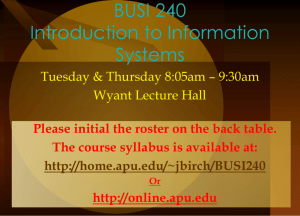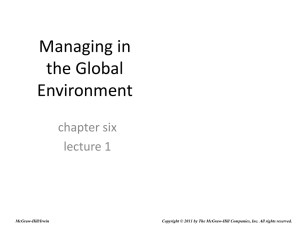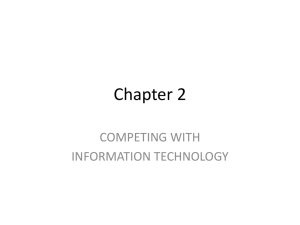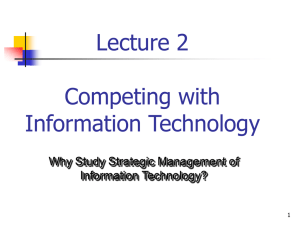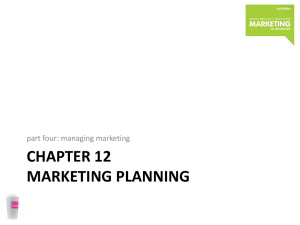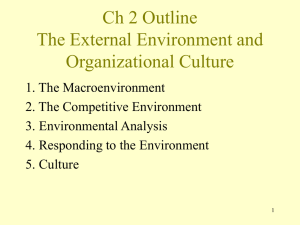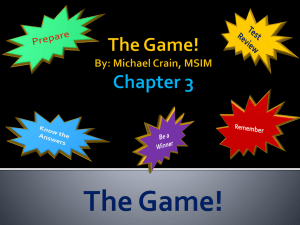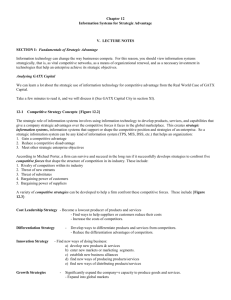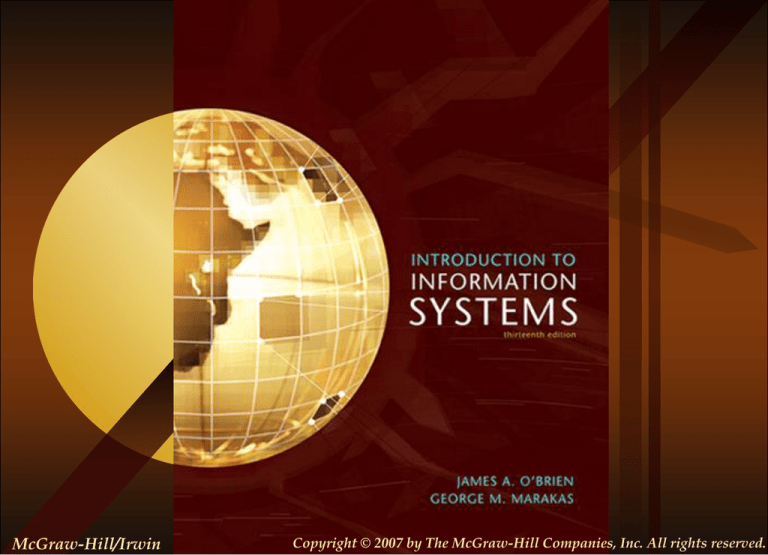
McGraw-Hill/Irwin
2-1
Copyright © 2007 by The McGraw-Hill Companies, Inc. All rights reserved.
Chapter
2
Competing with Information
Technology
How can a business use IT to compete?
Competitive strategies and forces
McGraw-Hill/Irwin
Copyright © 2007 by The McGraw-Hill Companies, Inc. All rights reserved.
Learning Objectives
Identify basic competitive strategies and explain
how a business can use IT to confront the
competitive forces it faces.
2. Identify several strategic uses of IT and give
examples of how they give competitive advantages
to a business.
3. Give examples of how business process
reengineering frequently involves the strategic use
of IT.
1.
2-3
Learning Objectives
Identify the business value of using Internet
technologies to become an agile competitor or to
form a virtual company.
5. Explain how knowledge management systems can
help a business gain strategic advantages.
4.
2-4
Case 1: GE, Dell, Intel, GM & others
The competitive advantage of IT
Does IT matter?
No:
Nicholas
Carr argues that IT is infrastructure like
electricity
Too commonplace to get competitive advantage
Yes:
IT
is not just networks and computers
The important part is the software and information and
how IT is used
2-5
Case Study Questions
1.
2.
2-6
Do you agree with the argument made by Nicholas
Carr to support his position that IT no longer gives
companies a competitive advantage? Why or why
not?
Do you agree with the argument made by the
business leaders in this cast in support of the
competitive advantage that IT can provide to a
business? Why or why not?
Case Study Questions
3.
What are several ways that IT could provide
competitive advantage to a business?
2-7
Use some of the companies mentioned in this case as
examples. Visit their websites to gather more
information to help you answer.
Real World Internet Activity
1.
Nicholas Carr’s article created a storm of debate
that is still raging.
Using the Internet, see if you can find Carr’s original
article.
Also try to find some more opinions for and against
Carr’s arguments beyond those provided in the case.
2-8
Real World Group Activity
2.
The core of Carr’s arguments has some significant
implications for businesses. In small groups,
What are some of the implications of the argument
that come to mind?
How might they serve to change the way we use
computers to support corporate strategy?
2-9
Strategic IT
Technology
is no longer an afterthought in forming
business strategy, but the actual cause and driver.
IT can change the way businesses compete.
A strategic information system is
Any
kind of information system
That uses IT to help an organization
2-10
Gain a competitive advantage
Reduce a competitive disadvantage
Or meet other strategic enterprise objectives
Competitive Forces and Strategies
2-11
Competitive Forces
If
a business wants to succeed must develop
strategies to counter these forces:
Rivalry
of competitors within its industry
Threat of new entrants into an industry and its markets
Threat posed by substitute products which might
capture market share
Bargaining power of customers
Bargaining power of suppliers
2-12
Five Competitive Strategies
Cost
Leadership
Become
low-cost producers
Help suppliers or customers reduce costs
Increase cost to competitors
Example, Priceline uses online seller bidding so buyer
sets the price
Differentiation
Develop
Strategy
ways to differentiate a firm’s products from its
competitors
Can focus on particular segment or niche of market
Example, Moen uses online customer design
2-13
Competitive Strategies (cont.)
Innovation Strategy
Find new ways of doing business
Unique products or services
Or unique markets
Radical changes to business processes to alter the fundamental
structure of an industry
Example, Amazon uses online full-service customer systems
Growth Strategy
Expand company’s capacity to produce
Expand into global markets
Diversify into new products or services
Example, Wal-Mart uses merchandise ordering by global
satellite tracking
2-14
Competitive strategies (cont.)
Alliance
Strategy
Establish
linkages and alliances with
Customers, suppliers, competitors, consultants and other
companies
Includes
mergers, acquisitions, joint ventures, virtual
companies
Example, Wal-Mart uses automatic inventory
replenishment by supplier
2-15
Using these strategies
The
strategies are not mutually exclusive
Organizations use one, some or all
2-16
Using IT for these strategies
2-17
Other competitive strategies
Lock
in customers and suppliers
And
lock out competitors
Deter them from switching to competitors
Build in switching costs
Make customers and suppliers dependent on the use of
innovative IS
Barriers
to entry
Discourage
or delay other companies from entering
market
Increase the technology or investment needed to enter
2-18
Other competitive strategies (cont.)
Include
IT components in products
Makes
substituting competing products more difficult
Leverage
investment in IT
Develop
IT
2-19
new products or services not possible without
Customer-focused business
What
is the business value in being customerfocused?
Keep
customers loyal
Anticipate their future needs
Respond to customer concerns
Provide top-quality customer service
Focus
on customer value
Quality
value
2-20
not price has become primary determinant of
How can we provide customer
value?
Track
individual preferences
Keep up with market trends
Supply products, services and information anytime,
anywhere
Provide customer services tailored to individual
needs
Use Customer Relationship Management (CRM)
systems to focus on customer
2-21
Building customer value using the
Internet
2-22
Value Chain
View
the firm as a chain of basic activities that add
value to its products and services
Activities are either
Primary
processes directly related to manufacturing or
delivering products
Support processes help support the day-to-day running
of the firm and indirectly contribute to products or
services
Use
the value chain to highlight where competitive
strategies can best be applied to add the most value
2-23
Using IS in the value chain
2-24
Case 2: The U.S. Department of Commerce
Using IT to tap experts’ know-how
DOC
uses DOC Insider to offer advice about how to
do business abroad
AskMe system includes:
Automated
best practices
Automatic experts’ profile creation
Methods for accessing and delivering knowledge
Real-time collaborative services
Analytic capabilities
2-25
Case Study Questions
1.
2.
3.
2-26
What are the key business challenges facing
companies in supporting their global marketing
and expansion efforts? How is the AskMe
knowledge management system helping to meet
this challenge? Explain.
How can the AskMe system help to identify
weaknesses in global business knowledge within
the DOC?
What other global trade situations could the AskMe
system provide information about? Provide some
examples.
Real World Internet Activity
1.
Knowledge management is considered by many to
be an essential element in gaining sustainable
competitive advantage in today’s marketplace.
2-27
Using the Internet, see if you can find information on
how organizations like the DOC are making use of
knowledge management technologies. Start your
investigation with the company that helped the DOC
at www.askmecorp.com.
Real World Group Activity
2.
Much of the knowledge in an organization takes
the form of tacit knowledge – knowledge that is
used regularly but not necessarily in a conscious
fashion.
Take the tacit knowledge test at
www.sveiby.com/articles/TacitTest.htm.
In small groups, discuss the outcome of the test.
Do you think tacit knowledge can be captured?
Discuss.
2-28
Business Process Reengineering
Called
BPR or Reengineering
Fundamental rethinking
and radical redesign
Of
business processes
To achieve improvements in cost, quality, speed and
service
Potential
payback high
Risk of failure is also high
2-29
How BPR differs from business
improvement
2-30
A cross-functional process
2-31
Reengineering order management
2-32
Agility
Agility
is the ability of a company to prosper
In
a rapidly changing, continually fragmenting
Global market for high-quality, high-performance,
customer-configured products and services
An
agile company can make a profit with
Broad
product ranges
Short model lifetimes
Mass customization
2-33
Individual products in large volumes
Four strategies for agility
An agile company:
Provides products as solutions to their customers’
individual problems
Cooperates with customers, suppliers and
competitors to bring products to market as quickly
and cost-effectively as possible
Organizes so that it thrives on change and
uncertainty
Leverages the impact of its people and the
knowledge they possess
2-34
How IT helps a company be agile
2-35
Virtual Company
A
virtual company uses IT to link
People,
Organizations,
Assets,
And
ideas
Creates
to
interenterprise information systems
link customers, suppliers, subcontractors and
competitors
2-36
A virtual company
2-37
Strategies of virtual companies
2-38
Knowledge Creation
Knowledge-creating
organization
Consistently creates
company or learning
new business knowledge
Disseminates it throughout the company
And builds in the new knowledge into its products and
services
2-39
Two kinds of knowledge
Explicit
knowledge
Data,
documents and things written down or stored on
computers
Tacit
knowledge
The
“how-to” knowledge which reside in workers’
minds
A
knowledge-creating company makes such tacit
knowledge available to others
2-40
Knowledge issues
What
is the problem with organizational knowledge
being tacit?
Why are incentives to share this knowledge needed?
2-41
Knowledge management
techniques
Source: Adapted from Marc Rosenberg, e-Learning: Strategies for Delivering Knowledge in the Digital Age
(New York: McGraw-Hill, 2001), p.70.
2-42
Knowledge management systems
(KMS)
KMS
manage organizational learning and business
know-how
Goal:
Help
knowledge workers to create, organize, and make
available knowledge
Whenever and wherever it’s needed in an organization
2-43
Case 3: CDW, Harrah’s Entertainment and Others
Developing Strategic Customer-Loyalty Systems
A
satisfied customer sees you as meeting
expectations
A loyal customer wants to do business with you
again and will recommend you to others.
A
good customer-loyalty system
Combines
customer feedback and business information
With sophisticated analysis
To create actionable results
IT
2-44
must take the lead in loyalty
Case Study Questions
1.
2.
3.
2-45
Does CDW’s customer loyalty program give them a
competitive advantage? Why?
What is the strategic value of Harrah’s approach to
determining and rewarding customer loyalty?
What else could CDW and Harrah’s do to truly
become customer-focused businesses? Visit their
websites to help you suggest several alternatives.
Real World Internet Activity
1.
We learned in this chapter that IT can be used to
support organizational strategies including
customer relationship management (CRM),
2-46
Using the Internet, explore how other firms besides
those in the case are managing their customer
relationships through IT. Start your investigation at
www.wanpress.org/rubrique127.html.
Real World Group Activity
2.
Managing customers involves more than simply
keeping track of their purchases with an
information system. In small groups,
Discuss the details of customer relationship
management from the customer’s perspective.
What does an organization have to do to maintain
their customers?
How can IT be used to improve customer experience
with an organization?
2-47

